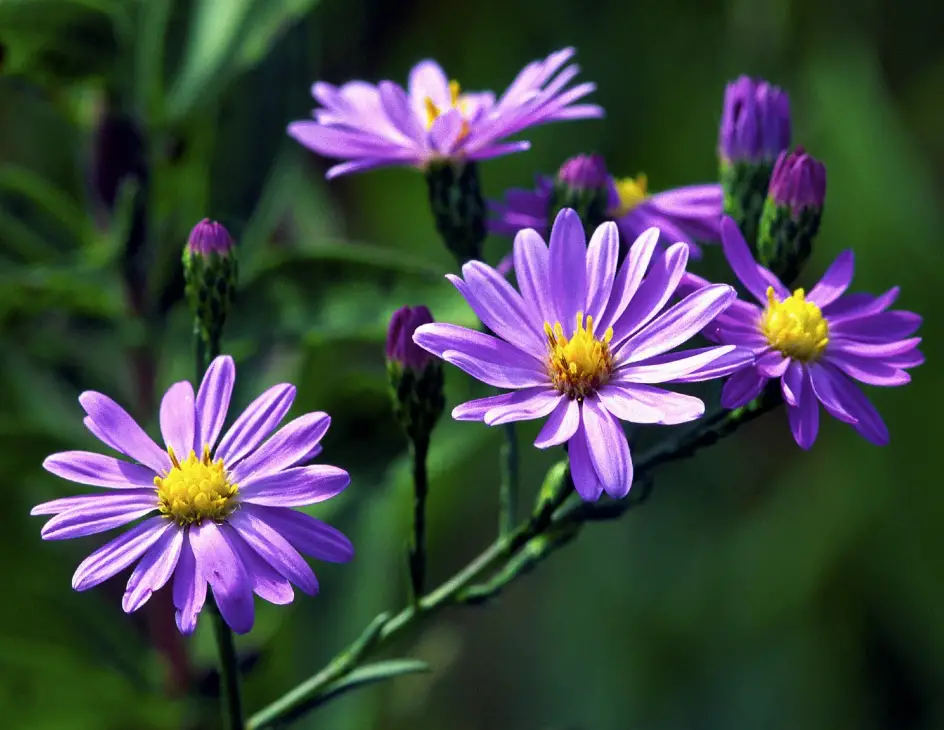Aster flowers are a beloved choice for gardeners seeking vibrant, late-season blooms that bring color and life to autumn landscapes. These stunning perennials, with their daisy-like flowers, range in shades of purple, pink, blue, and white. Native to North America, asters are not only attractive to the eye but also easy to grow with the right care.
This guide will cover everything you need to know about Aster flower care, from planting to propagation, ensuring your garden thrives year after year.
Overview of Aster Flowers

Asters are part of the Asteraceae family, a group that includes over 600 species. The flowers are particularly known for their star-shaped blooms, which is fitting given that the word “aster” comes from the Greek word for “star.” These flowers typically bloom from late summer through fall, making them a perfect addition to autumn gardens when many other plants have finished their flowering season.
Key Characteristics:
- Botanical Name: Symphyotrichum spp.
- Common Names: Asters, New England asters, frost flowers
- Mature Size: 1–6 ft. tall, 1–4 ft. wide
- Bloom Time: Late summer to fall (August through October)
- Flower Colors: Purple, pink, blue, white
- Sun Exposure: Full sun
- Hardiness Zones: 3-8 (USDA)
Asters not only provide beauty to your garden but also attract pollinators like bees and butterflies, which adds to their ecological value.
Planting Aster Flowers
Asters are relatively easy to grow, but they require certain conditions to flourish. If you’re starting from seeds, patience is key since it may take several years for your asters to mature. For faster results, many gardeners opt to plant nursery-grown asters, which provide more immediate growth and blooms.
Ideal Conditions for Planting Asters:
- Soil: Asters prefer loamy, well-drained soil with a slightly acidic pH. Loamy soil provides the right balance of sand, silt, and clay, which promotes proper drainage while retaining enough moisture for the plant. A slightly acidic environment (pH between 5.5 and 6.5) helps asters absorb essential nutrients effectively. To improve soil quality, you can enrich it by adding organic matter, such as compost, well-rotted manure, or leaf mold. These materials enhance soil structure, improve water retention, and increase the availability of nutrients.
- Sunlight: For optimal blooming, asters require full sun exposure. They thrive best when they receive at least six hours of direct sunlight per day. While some aster varieties can tolerate partial shade, plants grown in shaded conditions tend to become leggy, with fewer flowers and weaker growth. In full sun, asters produce an abundance of blooms, contributing to a vibrant fall garden.
- Spacing: Proper spacing is crucial for healthy aster growth. Space plants 1 to 3 feet apart, depending on the variety. Adequate spacing allows their roots to expand, ensuring access to nutrients and water. It also improves air circulation, reducing the risk of diseases like powdery mildew and root rot, which can develop in crowded, poorly ventilated environments.
Watering and Fertilizing Asters
Asters are relatively low-maintenance, but consistent care is important to ensure lush blooms throughout the season.
Watering Tips:
- Asters need regular watering, especially when newly planted. The soil should be kept moist but not soggy, as waterlogged soil can lead to root rot.
- Aim to provide about 1 inch of water per week, either through rainfall or irrigation. When watering, focus on the base of the plant to avoid wetting the leaves, which can encourage fungal diseases like powdery mildew.
Fertilizing Tips:
- Asters benefit from a balanced flower fertilizer applied twice a month, starting in early spring and continuing until the plants begin to bloom.
- Be cautious not to over-fertilize, as this can result in fewer blooms. Cease fertilizing by August to avoid encouraging excessive leaf growth at the expense of flowers.
Pruning and Dividing Asters
Pruning is a crucial part of keeping your asters healthy and ensuring a prolonged bloom period. Deadheading, or removing spent flowers, encourages new blooms and helps keep the plant looking tidy.
Pruning Tips:
- Pinch back the tips of the asters in late spring or early summer to encourage bushier growth and prevent the plants from becoming too tall and leggy.
- Remove any dead or dying stems to allow the plant to focus its energy on producing fresh blooms.
Dividing asters every three years or so is also essential for their longevity. Over time, asters can become woody and die out in the center, which can be prevented by dividing the root clumps.
How to Divide Asters:
- Dig up the entire root clump in either late fall or early spring.
- Use a sharp spade to divide the clump into smaller sections. Discard the woody center.
- Replant the new divisions at the same depth they were previously growing.
- Water thoroughly and mulch around the new plants to help retain moisture.
Common Aster Varieties
There are many different varieties of asters to choose from, each offering a unique color and growth habit. Here are a few popular cultivars:
- ‘Celeste’: Known for its deep blue flowers with bright yellow centers, this variety blooms early in the season.
- ‘Hazy’: This aster produces raspberry-pink flowers and is an early bloomer.
- ‘Puff’: A hardy white-flowered variety, ‘Puff’ is among the first asters to bloom in the season.
Overwintering Asters
Asters are frost-hardy perennials, meaning they can survive winter with proper care. Once the blooming season is over, it’s essential to prepare your asters for the colder months.
Steps for Overwintering:
- After the first frost, cut back the foliage to ground level or leave it until spring if you want to provide food for birds like chickadees and finches.
- Apply a layer of mulch around the base of the plant to protect the roots from freezing temperatures.
- Water the plants deeply before the first freeze to help them withstand the winter.
Pest and Disease Control
Asters are relatively resistant to pests, but some insects and diseases can occasionally cause problems.
Common Issues:
- Rust and Powdery Mildew: These fungal diseases can affect aster foliage, especially if plants are overcrowded or exposed to wet conditions. Proper spacing and watering practices can help prevent these problems.
- Lace Bugs: These tiny bugs can cause yellowing and leaf drop. If you notice damage, consider using an insecticidal soap to control the infestation.
Encouraging Aster Blooms
While asters are typically reliable bloomers, a few factors can impact their performance. If your asters are not flowering as expected, check for the following issues:
- Sunlight: Ensure they are receiving at least six hours of sunlight daily.
- Water: Make sure the plants are getting about 1 inch of water per week.
- Nutrient Levels: Too much or too little fertilizer can impact blooming. Make sure you’re using a balanced fertilizer and not overfeeding the plants.
Conclusion
Aster flowers are a fantastic choice for any garden, offering late-season color and a habitat for pollinators. By following this care and growing guide, you can enjoy vibrant, healthy asters that return year after year. With the right soil, sunlight, and watering routine, your garden will be graced with stunning aster blooms from late summer through fall.
By understanding their needs, including regular pruning and division, you’ll ensure that your asters remain a beautiful, long-lasting feature of your garden.






